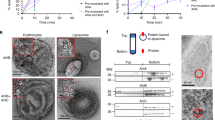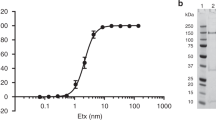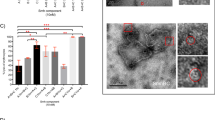Abstract
Pore-forming toxins (PFTs) are a class of potent virulence factors that convert from a soluble form to a membrane-integrated pore1. They exhibit their toxic effect either by destruction of the membrane permeability barrier or by delivery of toxic components through the pores. Among the group of bacterial PFTs are some of the most dangerous toxins, such as diphtheria and anthrax toxin. Examples of eukaryotic PFTs are perforin and the membrane-attack complex, proteins of the immune system2. PFTs can be subdivided into two classes, α-PFTs and β-PFTs, depending on the suspected mode of membrane integration, either by α-helical or β-sheet elements3. The only high-resolution structure of a transmembrane PFT pore is available for a β-PFT—α-haemolysin from Staphylococcus aureus4. Cytolysin A (ClyA, also known as HlyE), an α-PFT, is a cytolytic α-helical toxin responsible for the haemolytic phenotype of several Escherichia coli and Salmonella enterica strains5,6,7,8. ClyA is cytotoxic towards cultured mammalian cells, induces apoptosis of macrophages and promotes tissue pervasion9,10,11. Electron microscopic reconstructions demonstrated that the soluble monomer of ClyA12 must undergo large conformational changes to form the transmembrane pore13,14. Here we report the 3.3 Å crystal structure of the 400 kDa dodecameric transmembrane pore formed by ClyA. The tertiary structure of ClyA protomers in the pore is substantially different from that in the soluble monomer. The conversion involves more than half of all residues. It results in large rearrangements, up to 140 Å, of parts of the monomer, reorganization of the hydrophobic core, and transitions of β-sheets and loop regions to α-helices. The large extent of interdependent conformational changes indicates a sequential mechanism for membrane insertion and pore formation.
This is a preview of subscription content, access via your institution
Access options
Subscribe to this journal
Receive 51 print issues and online access
$199.00 per year
only $3.90 per issue
Buy this article
- Purchase on Springer Link
- Instant access to full article PDF
Prices may be subject to local taxes which are calculated during checkout




Similar content being viewed by others
References
Parker, M. W. & Feil, S. C. Pore-forming protein toxins: from structure to function. Prog. Biophys. Mol. Biol. 88, 91–142 (2005)
Voskoboinik, I., Smyth, M. J. & Trapani, J. A. Perforin-mediated target-cell death and immune homeostasis. Nature Rev. Immunol. 6, 940–952 (2006)
Gouaux, E. Channel-forming toxins: tales of transformation. Curr. Opin. Struct. Biol. 7, 566–573 (1997)
Song, L. Z. et al. Structure of staphylococcal α-hemolysin, a heptameric transmembrane pore. Science 274, 1859–1866 (1996)
del Castillo, F. J., Leal, S. C., Moreno, F. & delCastillo, I. The Escherichia coli K-12 sheA gene encodes a 34-kDa secreted haemolysin. Mol. Microbiol. 25, 107–115 (1997)
Oscarsson, J. et al. Characterization of a pore-forming cytotoxin expressed by Salmonella enterica serovars Typhi and Paratyphi A. Infect. Immun. 70, 5759–5769 (2002)
Ludwig, A., von Rhein, C., Bauer, S., Huttinger, C. & Goebel, W. Molecular analysis of cytolysin a (ClyA) in pathogenic Escherichia coli strains. J. Bacteriol. 186, 5311–5320 (2004)
von Rhein, C. et al. ClyA cytolysin from Salmonella: distribution within the genus, regulation of expression by SlyA, and pore-forming characteristics. Int. J. Med. Microbiol. 299, 21–35 (2009)
Oscarsson, J. et al. Molecular analysis of the cytolytic protein ClyA (SheA) from Escherichia coli . Mol. Microbiol. 32, 1226–1238 (1999)
Lai, X. H. et al. Cytocidal and apoptotic effects of the ClyA protein from Escherichia coli on primary and cultured monocytes and macrophages. Infect. Immun. 68, 4363–4367 (2000)
Fuentes, J. A., Villagra, N., Castillo-Ruiz, M. & Mora, G. C. The Salmonella Typhi hlyE gene plays a role in invasion of cultured epithelial cells and its functional transfer to S. Typhimurium promotes deep organ infection in mice. Res. Microbiol. 159, 279–287 (2008)
Wallace, A. J. et al. coli hemolysin E (HlyE, ClyA, SheA): X-ray crystal structure of the toxin and observation of membrane pores by electron microscopy. Cell 100, 265–276 (2000)
Eifler, N. et al. Cytotoxin ClyA from Escherichia coli assembles to a 13-meric pore independent of its redox-state. EMBO J. 25, 2652–2661 (2006)
Tzokov, S. B. et al. Structure of the hemolysin E (HlyE, ClyA, and SheA) channel in its membrane-bound form. J. Biol. Chem. 281, 23042–23049 (2006)
Ludwig, A., Bauer, S., Benz, R., Bergmann, B. & Goebel, W. Analysis of the SlyA-controlled expression, subcellular localization and pore-forming activity of a 34 kDa haemolysin (ClyA) from Escherichia coli K-12. Mol. Microbiol. 31, 557–567 (1999)
Shepard, L. A. et al. Identification of a membrane-spanning domain of the thiol-activated pore-forming toxin Clostridium perfringens perfringolysin O: an α-helical to β-sheet transition identified by fluorescence spectroscopy. Biochemistry 37, 14563–14574 (1998)
Atkins, A. et al. Structure–function relationships of a novel bacterial toxin, hemolysin E: the role of αG. J. Biol. Chem. 275, 41150–41155 (2000)
Earp, L. J., Delos, S. E., Park, H. E. & White, J. M. The many mechanisms of viral membrane fusion proteins. Curr. Top. Microbiol. Immunol. 285, 25–66 (2005)
Wyborn, N. R. et al. Properties of haemolysin E (HlyE) from a pathogenic Escherichia coli avian isolate and studies of HlyE export. Microbiology 150, 1495–1505 (2004)
Tilley, S. J., Orlova, E. V., Gilbert, R. J. C., Andrew, P. W. & Saibil, H. R. Structural basis of pore formation by the bacterial toxin pneumolysin. Cell 121, 247–256 (2005)
Kawate, T. & Gouaux, E. Arresting and releasing Staphylococcal α-hemolysin at intermediate stages of pore formation by engineered disulfide bonds. Protein Sci. 12, 997–1006 (2003)
Engelman, D. M. & Steitz, T. A. The spontaneous insertion of proteins into and across membranes: the helical hairpin hypothesis. Cell 23, 411–422 (1981)
Farsad, K. & De Camilli, P. Mechanisms of membrane deformation. Curr. Opin. Cell Biol. 15, 372–381 (2003)
Wai, S. N. et al. Vesicle-mediated export and assembly of pore-forming oligomers of the enterobacterial ClyA cytotoxin. Cell 115, 25–35 (2003)
Olson, R., Nariya, H., Yokota, K., Kamio, Y. & Gouaux, E. Crystal structure of staphylococcal LukF delineates conformational changes accompanying formation of a transmembrane channel. Nature Struct. Biol. 6, 134–140 (1999)
Hunt, S. et al. The formation and structure of Escherichia coli K-12 haemolysin E pores. Microbiology 154, 633–642 (2008)
Carr, C. M., Kim, P. S. & Spring-Loaded, A. Mechanism for the conformational change of influenza hemagglutinin. Cell 73, 823–832 (1993)
Colman, P. M. & Lawrence, M. C. The structural biology of type I viral membrane fusion. Nature Rev. Mol. Cell Biol. 4, 309–319 (2003)
Emsley, P. & Cowtan, K. Coot: model-building tools for molecular graphics. Acta Crystallogr. D 60, 2126–2132 (2004)
Adams, P. D. et al. PHENIX: building new software for automated crystallographic structure determination. Acta Crystallogr. D 58, 1948–1954 (2002)
Kabsch, W. Automatic processing of rotation diffraction data from crystals of initially unknown symmetry and cell constants. J. Appl. Cryst. 26, 795–800 (1993)
Collaborative Computational Project Number 4 The CCP4 suite: programs for protein crystallography. Acta Crystallogr. D 50, 760–763 (1994)
Evans, P. R. Scala. in Joint CCP4 and ESF-EACBM Newsletter on Protein Crystallography 33, 22–24 (1997)
French, S. & Wilson, K. On the treatment of negative intensity observations. Acta Crystallogr. A 34, 517–525 (1978)
Tong, L. & Rossmann, M. G. Rotation function calculations with GLRF program. Meth. Enzymol. 276, 594–611 (1997)
Pape, T. & Schneider, T. R. HKL2MAP: a graphical user interface for macromolecular phasing with SHELX programs. J. Appl. Cryst. 37, 843–844 (2004)
Schneider, T. R. & Sheldrick, G. M. Substructure solution with SHELXD. Acta Crystallogr. D 58, 1772–1779 (2002)
delaFortelle, E. & Bricogne, G. Maximum-likelihood heavy-atom parameter refinement for multiple isomorphous replacement and multiwavelength anomalous diffraction methods. Meth. Enzymol. 276, 472–494 (1997)
Brunger, A. T. et al. Crystallography & NMR system: a new software suite for macromolecular structure determination. Acta Crystallogr. D 54, 905–921 (1998)
Terwilliger, T. C. Maximum-likelihood density modification. Acta Crystallogr. D 56, 965–972 (2000)
Jones, T. A. A graphics model building and refinement system for macromolecules. J. Appl. Cryst. 11, 268–272 (1978)
Mccoy, A. J. et al. Phaser crystallographic software. J. Appl. Cryst. 40, 658–674 (2007)
Cowtan, K. The Buccaneer software for automated model building. 1. Tracing protein chains. Acta Crystallogr. D 62, 1002–1011 (2006)
Painter, J. & Merritt, E. A. TLSMD web server for the generation of multi-group TLS models. J. Appl. Cryst. 39, 109–111 (2006)
Laskowski, R. A., Macarthur, M. W., Moss, D. S. & Thornton, J. M. Procheck — a program to check the stereochemical quality of protein structures. J. Appl. Cryst. 26, 283–291 (1993)
Krissinel, E. & Henrick, K. Inference of macromolecular assemblies from crystalline state. J. Mol. Biol. 372, 774–797 (2007)
DeLano, W. L. The PyMOL Molecular Graphics System 〈http://www.pymol.org/〉 (2008)
Acknowledgements
We thank B. Blattmann for help with initial screening, N. Eifler and A. Engel for providing electron microscopy maps, D. Boehringer for sample characterization, and H. Fäh-Rechsteiner for technical assistance. We also acknowledge the staff of X06SA at the Swiss Light Source for developing an excellent beamline and support with data collection, T. C. Terwilliger for his support using RESOLVE, and M. Leibundgut and D. Boehringer for critically reading the manuscript. This work was supported by the Swiss National Science Foundation (SNSF) and the National Center of Excellence in Research (NCCR) Structural Biology program of the SNSF.
Author information
Authors and Affiliations
Corresponding author
Supplementary information
Supplementary Information
This file contains Supplementary Table 1, Supplementary Figures 1-8 with Legends and Supplementary References. (PDF 6719 kb)
Rights and permissions
About this article
Cite this article
Mueller, M., Grauschopf, U., Maier, T. et al. The structure of a cytolytic α-helical toxin pore reveals its assembly mechanism. Nature 459, 726–730 (2009). https://doi.org/10.1038/nature08026
Received:
Accepted:
Published:
Issue Date:
DOI: https://doi.org/10.1038/nature08026
This article is cited by
-
Story of Pore-Forming Proteins from Deadly Disease-Causing Agents to Modern Applications with Evolutionary Significance
Molecular Biotechnology (2023)
-
Polymerized porin as a novel delivery platform for coronavirus vaccine
Journal of Nanobiotechnology (2022)
-
Nanocarriers based on bacterial membrane materials for cancer vaccine delivery
Nature Protocols (2022)
-
Palmitoylated acyl protein thioesterase APT2 deforms membranes to extract substrate acyl chains
Nature Chemical Biology (2021)
-
Cryo-EM structures of an insecticidal Bt toxin reveal its mechanism of action on the membrane
Nature Communications (2021)
Comments
By submitting a comment you agree to abide by our Terms and Community Guidelines. If you find something abusive or that does not comply with our terms or guidelines please flag it as inappropriate.



